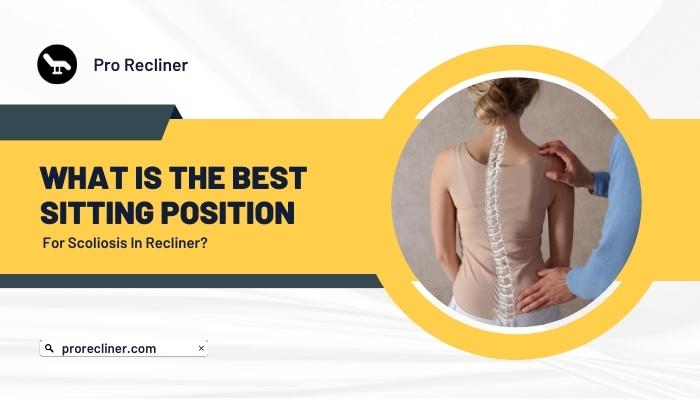The human body is considered no less than sophisticated machinery since it has so many parts that complement each other to ensure you carry on your everyday routine seamlessly without any hurdles.
All credit is due to the spinal cord, which ensures the mobility of the body stays intact, but In spite of being incomprehensibly complex, it is still undoubtedly prone to tons of diseases and malfunction.
One such prominent malfunction includes Scoliosis, which affects the curvature of a human body regardless of the age of a person, causing insufferable pain and unimaginable hurdles in daily life.
To make matters worse, in its later stages, patients suffering from such spinal abnormalities also suffer in agony even while sitting or taking a nap, and only a well-adjusted recliner can be deemed helpful when dealing with this fiasco.
So What Is The Best Sitting Position For Scoliosis In a Recliner you may ask? Well, I would advise you to keep on reading, as I have mentioned a couple of adjustments for your recliner so you can easily maintain a good posture and rectify the pain to a greater extent.
But first, let’s understand the type of Curvature caused due to Scoliosis,
What Is the Best Sitting Position for Scoliosis in Recliner?
lets discuss this :
Types Of Curvature
Acknowledging the type of Curvature induced on your Spinal cord is extremely important because, with this information, you can efficiently perform the tweaks on your recliner while adjusting it.
Typically, there are two types of Curvatures,
1. C-Shaped Scoliosis
A moderate form of scoliosis, as it includes a single curve in the thoracic or lumbar region. As the name suggests, C- C-shaped scoliosis can affect the spine at the upper or lower region of vertebrae, causing it to look like the Alphabet “C.”
This happens when the spine bends to one side, either to the right (dextroscoliosis) or to the left (levoscoliosis).
The curve can be mild, moderate, or severe. Depending on its location and severity, C-shaped scoliosis can cause a variety of symptoms, including back pain, uneven shoulders or hips, and difficulty standing straight.
2. S-Shaped Scoliosis
It is a moderate to extreme form of abnormally caused by Scoliosis, which also happens in both the upper and lower spine; however, the curvature happens in opposite formations against each other, resembling much the Alphabet “S.”
In some scenarios, either through genetic or environmental factors, the curvature abnormality is exacerbated to the point it has more than one curve which resembles both “S” and “C”.
The cause of S-shaped scoliosis is often unknown (idiopathic), but it can also be caused by underlying conditions such as neuromuscular disorders or congenital abnormalities.
How Is the Curvature Measured?
A Curvature in the Spine is measured through the Cobb Angle. A Cobb angle is a measurement used to quantify the degree of curvature in the spine, particularly in cases of scoliosis.
It is determined by identifying the most tilted vertebrae at the top and bottom of the curve and then measuring the angle between the lines drawn along the edges of these vertebrae.
If a Cobb angle is less than 20, scoliosis is considered at its early stages with mild effect at the curvature of the spinal cord.
Anywhere above 20, the Cobb angle is considered moderate to extreme, and the patient may require braces or surgery to rectify the problem.
What Is the Best Sitting Position for Scoliosis in Recliner?
Unlike individuals with normal curvature, there is no specific “angle” to sit at when sitting in a recliner, which is why the best position to adjust your recliner is at a neutral position, which correlates to your Cobb angle.
This will help you maximize comfort while preventing stress on your spine. Here is how you can achieve this position.
- Never hunch or slouch, as it can exacerbate your scoliosis.
- Align your back to the backrest of a recliner and make sure your buttocks lay flat on the seat.
- Make sure your feet are positioned flat, and lower the seat so that your knees are congested.
- While achieving a neutral position, never cross your legs, as your buttocks might become misaligned, resulting in unnecessary stress on the lower and upper spinal regions.
- If necessary, a pillow can help you align your pelvis or buttocks to achieve a neutral position much more accurately.
- Avoid receding the backrest too much, especially if your Cobb angle is above 20.
Bottom Line
While spinal abnormalities relating to curvature caused by scoliosis can only be rectified through surgery or using braces such as Boston, Milwaukee, Wilmington, Charleston, or Providence braces, positioning yourself on a recliner by keeping your pelvis in a neutral position can help in providing relief needed for the sick and the ailing.
Keep in mind that you must never cross your legs when calibrating your spine across the backrest, and make sure your feet lay flat against the ground.
That being said, feel free to bookmark this article, as I will be curating more articles on esoteric topics like these.

I am a furniture expert with a passion for recliners. With years of experience in the industry, I offer invaluable insights and creative ideas for selecting the perfect recliner to suit any space and your needs.
